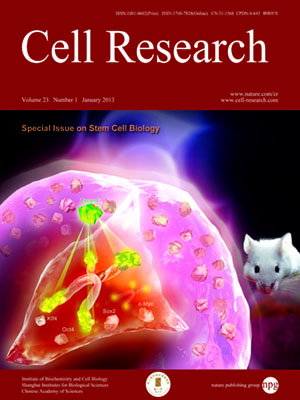
Advanced Search
Submit Manuscript
Advanced Search
Submit Manuscript
Volume 23, No 1, Jan 2013
ISSN: 1001-0602
EISSN: 1748-7838 2018
impact factor 17.848*
(Clarivate Analytics, 2019)
Volume 23 Issue 1, January 2013: 142-156
Xudong Guo1,*, Qidong Liu1,*, Guiying Wang1, Songcheng Zhu1, Longfei Gao1, Wujun Hong1, Yafang Chen1, Minjuan Wu2, Houqi Liu2, Cizhong Jiang1
1Clinical and Translational Research Center of Shanghai First Maternity & Infant Health Hospital, Shanghai Key Laboratory of Signaling and Disease Research, School of Life Science and Technology, Tongji University, 1239 Siping Road, Shanghai 200092, China
2Department of Embryology and Histology, Second Military Medical University, Shanghai 200433, China
Correspondence: Jiuhong Kang(jhkang@tongji.edu.cn)
Fibroblasts can be reprogrammed into induced pluripotent stem cells (iPSCs) by the application of Yamanaka factors (OSKM), but the mechanisms underlying this reprogramming remain poorly understood. Here, we report that Sox2 directly regulates endogenous microRNA-29b (miR-29b) expression during iPSC generation and that miR-29b expression is required for OSKM- and OSK-mediated reprogramming. Mechanistic studies show that Dnmt3a and Dnmt3b are in vivo targets of miR-29b and that Dnmt3a and Dnmt3b expression is inversely correlated with miR-29b expression during reprogramming. Moreover, the effect of miR-29b on reprogramming can be blocked by Dnmt3a or Dnmt3b overexpression. Further experiments indicate that miR-29b-DNMT signaling is significantly involved in the regulation of DNA methylation-related reprogramming events, such as mesenchymal-to-epithelial transition (MET) and Dlk1-Dio3 region transcription. Thus, our studies not only reveal that miR-29b is a novel mediator of reprogramming factor Sox2 but also provide evidence for a multistep mechanism in which Sox2 drives a miR-29b-DNMT signaling axis that regulates DNA methylation-related events during reprogramming.
Cell Research (2013) 23:142-156. doi:10.1038/cr.2012.180; published online 25 December 2012